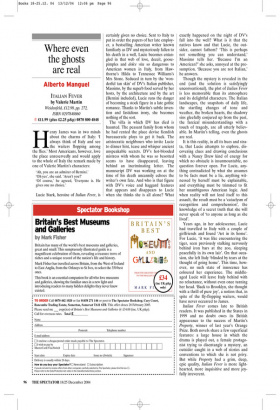Where even the ghosts are real
Alberto Manguel
ITALIAN FEVER by Valerie Martin Weidenfeld, £12.99, pp. 272, ISBN 0297848860 ✆ £11.99 (plus £2.25 p&p) 0870 800 4848 Henry James was in two minds about the charms of Italy: ‘I always think of Italy and see the waiters flopping among the flies.’ Most Americans, however, love the place unreservedly and would apply to the whole of Italy the remark made by one of Valerie Martin’s characters:
‘Ah, you are an admirer of Bernini.’ ‘Oh yes’, she said. ‘Aren’t you?’ ‘Of course,’ he agreed, ‘Everyone is. He gives one no choice.’
Lucie Stark, heroine of Italian Fever, is certainly given no choice. Sent to Italy to put in order the papers of her late employer, a bestselling American writer known familiarly as DV and mysteriously fallen to his death in a well, Lucie becomes entangled in that web of love, deceit, goosepimples and dolce vita so dangerous to American women in Italy, from Hawthorne’s Hilda to Tennessee Williams’s Mrs Stone. Seduced in turn by the ‘wonderful tan skin’ of DV’s Italian publisher, Massimo, by the superb food served by her hosts, by the architecture and by the art (Bernini included), Lucie runs the danger of becoming a stock figure in a late gothic romance. Thanks to Martin’s subtle invention and fastidious irony, she becomes nothing of the sort.
The villa in which DV has died is haunted. The peasant family from whom he had rented the place devise fiendish bureaucratic ploys to get it back. The aristocratic neighbours who invite Lucie to dinner hint, tease and whisper ancient unspeakable secrets. DV’s hot-blooded mistress with whom he was so besotted seems to have disappeared, leaving behind an incriminating letter. The manuscript DV was working on at the time of his death uncannily echoes the writer’s own fate. And who is that figure with DV’s voice and haggard features that appears and disappears to Lucie when she thinks she is all alone? What exactly happened on the night of DV’s fall into the well? What is it that the natives know and that Lucie, the outsider, cannot fathom? ‘This is perhaps not something you can understand,’ Massimo tells her. ‘Because I’m an American?’ she asks, annoyed at the presumption. ‘Because you are not Italian,’ he answers.
Though the mystery is revealed in the end (and the solution is satisfyingly unconventional), the plot of Italian Fever is less memorable than its atmosphere and its delightful characters. The Italian landscapes, the snapshots of daily life, the startling changes of tone and weather, the broken hearts, the shadowy sins gleefully conjured up from the past, the farcical misunderstandings with a touch of tragedy, are all utterly believable. In Martin’s telling, even the ghosts are real.
It is this reality, in all its hues and strata, that Lucie attempts to explore, discovering clues and drawing conclusions with a Nancy Drew kind of energy for which no obstacle is insurmountable, no question forever open. For Lucie, anything contradicted by what she assumes to be facts must be a lie, anything witnessed by herself must be explainable, and everything must be trimmed to fit her unambiguous American logic. And when reality will not lend itself to this assault, the result must be a ‘cataclysm of recognition and comprehension’, the knowledge of a secret truth that she will never speak of ‘to anyone as long as she lived’.
Years ago, in her adolescence, Lucie had travelled to Italy with a couple of girlfriends and found ‘Art in its home’. For Lucie, ‘it was like encountering the tiger, seen previously stalking nervously behind iron bars at the zoo, sleeping peacefully in its own lair’. On that occasion, she left Italy ‘blinded by tears at the thought of going home’. This time, however, no such state of innocence has coloured her experience. The middleaged Lucie will leave Italy behind with no reluctance, without even once turning her head. ‘Back to Brooklyn, she thought with a thrill of pure joy’, a notion that, in spite of the fly-flopping waiters, would have never occurred to James.
Italian Fever comes late to British readers. It was published in the States in 1999 and no doubt owes its British appearance to the success of Martin’s Property, winner of last year’s Orange Prize. Both novels share a few superficial features: a large house in which the drama is played out, a female protagonist trying to disentangle a mystery, an outsider caught in a web of stories and conventions to which she is not privy. But while Property had a grim, deep, epic quality, Italian Fever is more lighthearted, more inquisitive and more joyfully irreverent.

















































































 Previous page
Previous page